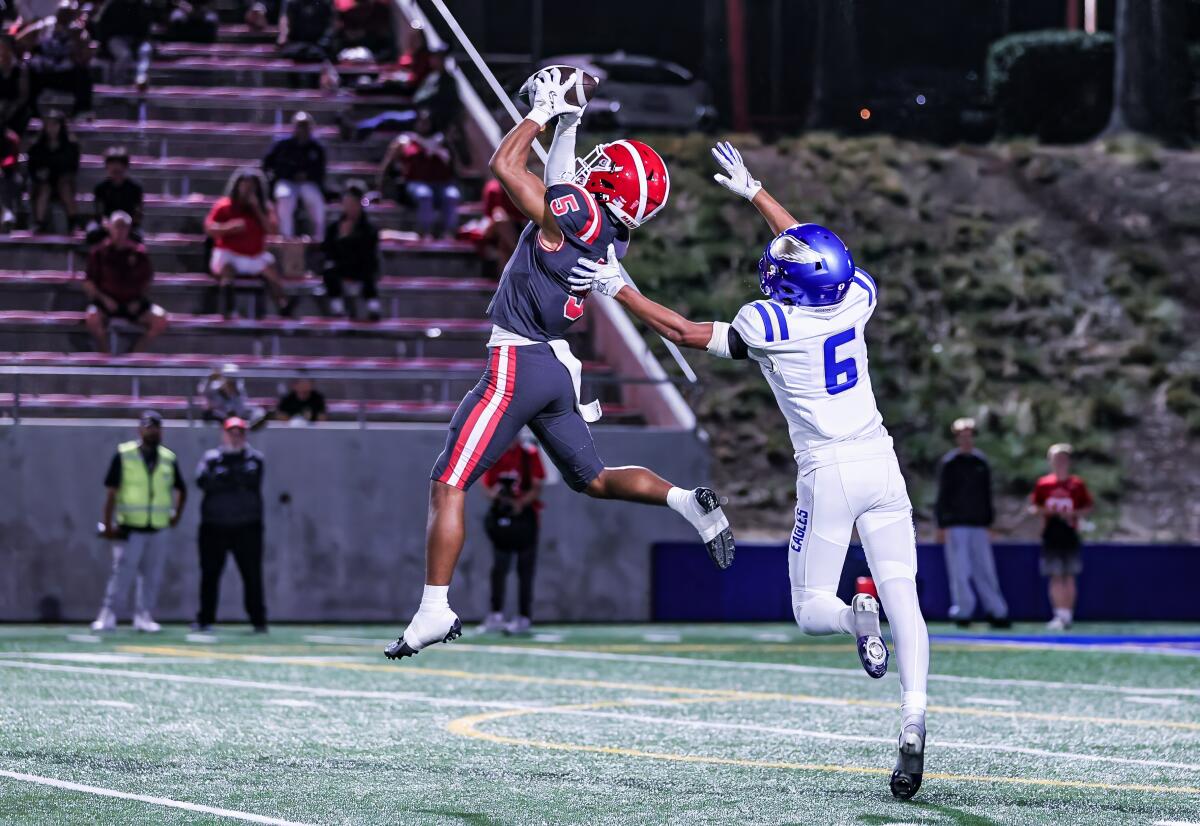Santa Margarita shuts down Mater Dei for low-scoring win
Trent Mosley itched and itched, the discomfort of standing on the sideline — not his foot injury that held him out of action since Aug. 22 — weighing on the senior receiver.
The USC commit picked an exceptional time to return. Trailing by six, with 5:06 remaining in the game, Mosley took the snap in the wildcat formation and swerved his way into the end zone for a touchdown.
“It sucked just knowing I couldn’t go out there and help my teammates,” Mosley said. “Now I’m back and we’re getting better.”
The score and the hush of the normally raucous Santa Ana Stadium crowd told the story: For the first time in a long while, the Trinity League is up for grabs. Santa Margarita (5-2, 2-0) played Southern Section stunner on Friday night at Santa Ana Stadium, upsetting Mater Dei 7-6 to set the stage for a thrilling Trinity League finale after the Eagles took down the Monarchs (4-2, 1-1) for the first time since 2013.
“Incredible,” Santa Margarita coach Carson Palmer said. “They’ve been playing like the best defense in the country all year long, every week.”
Palmer pointed to defensive coordinator Steve Fifita, who served as interim head coach during last season and decided to stay on the Eagles’ staff as the catalyst for Santa Margarita’s success. Mater Dei had only 175 yards on offense Friday.
Mater Dei High’s CJ Lavender Jr. intercepts a pass intended for Santa Margarita receiver Grant Mosley on Friday night.
(Craig Weston)
“They’re [Fifita’s] heartbeat on defense,” Palmer said of the group, which includes Fifita’s nephew Dash, a senior linebacker.
Pound-for-pound, the defensive lines of Santa Margarita and Mater Dei wouldn’t budge.
Eagles senior linebacker Vai Manutai would secure a sack — while moments later Monarchs linemen Montana Loilolo and Matamatagi Uiagalelei stormed through for sacks of their own. Monarchs linebacker Shaun Scott forced a fumble and earned 1 1/2 sacks as the Eagles couldn’t break 25 rushing yards.
Mater Dei quarterback Ryan Hopkins never got comfortable — outside of a 10-yard touchdown strike to Kayden Dixon-Wyatt in the first quarter — eventually throwing an interception to Eagles defensive back Davide Morales as the third quarter came to a close.
“We’re right there, but we’re not quite there,” said Mater Dei coach Raul Lara, referring to plays such as Hopkins overthrowing wide receiver Gavin Honore for a potential game-winning touchdown, which instead became a turnover on downs with 2:06 remaining.
Lara continued: “This game of football is a great tool to teach young men life skills. Not everything in life is going to be perfect.”
Quarterback Trace Johnson of Santa Margarita could not get comfortable , tossing two interceptions into the hands of Mater Dei defensive back CJ Lavender Jr.
When Johnson found open space, it was thanks to Mosley.
For a team-high six catches for 51 yards, Mosley — who often lined up next to his brother Grant in the slot — helped set up the game-winning drive after freshman running back Adrian Petero hauled in a 59-yard catch to bring the Eagles into Monarchs’ territory.
Trent Mosley’s punch in and the point after — which was enough to win after a failed two-point conversion after Dixon-Wyatt’s score — now sets up unprecedented territory in recent Trinity League seasons.
Yes, Mater Dei and St. John Bosco (which defeated Orange Lutheran 48-0 Friday) will still be contenders.
But the Eagles, who also hold a win over Corona Centennial, can certainly consider themselves as contenders for the league’s crown — and maybe even Division 1 glory. Santa Margarita plays St. John Bosco on Friday at Trabuco Hills.
“We can go forever,” Trent Mosley said. “The culture we have, the bond we have — I know what we’re capable of.”
